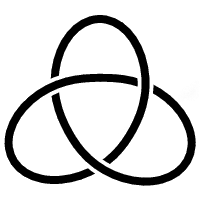In mathematics, racks and quandles are sets with a binary operations satisfying axioms analogous to the Reidemeister moves used to manipulate knot diagrams. While mainly used to obtain invariants of knots, they can be viewed as algebraic constructions in their own right. In particular, the definition of a quandle axiomatizes the properties of conjugation in a group.
The earliest known work on racks is contained within (unpublished) 1959 correspondence between John Conway and Gavin Wraith,[1] who at the time were undergraduate students at the University of Cambridge. Wraith had become interested in these structures (which he initially dubbed sequentials) while at school.[2] Conway renamed them wracks, partly as a pun on his colleague's name, and partly because they arise as the remnants (or 'wrack and ruin') of a group when one discards the multiplicative structure and considers only the conjugation structure. The spelling 'rack' has now become prevalent.
Click here for more information on quandles.
Laboratory for Algebraic and Symbolic Computation
ASC Lab at Bard College
